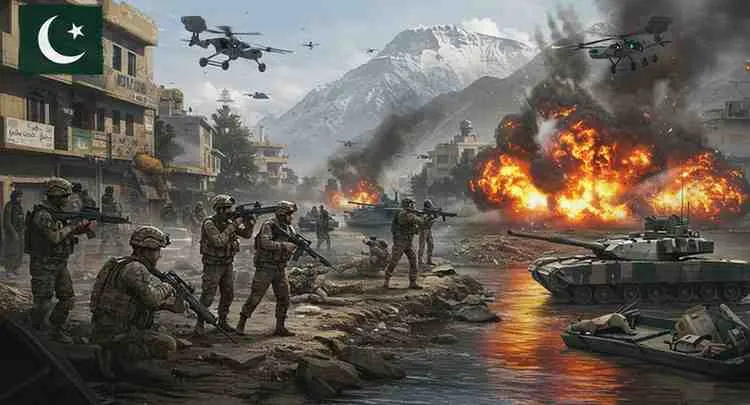Introduction
On May 7, 2025, the long-simmering rivalry between Pakistan and India erupted into its most serious confrontation in years. In response to a deadly terror strike near Pahalgam, New Delhi launched Operation Sindoor, a coordinated series of cross-border missile and air strikes against militant infrastructure in Pakistan-administered Kashmir. This article offers an exhaustive review of:
A step-by-step timeline of Operation Sindoor May 7, 2025
The nine militant bases targeted by Indian forces
Mechanics of cross‐border missile strikes and aerial raids
Pakistan’s countermeasures, including airspace closure India–Pakistan
Civilian consequences: casualties, travel disruptions, and emergency orders in Punjab
Worldwide reactions from the UN, major powers, and regional neighbors
The Pahalgam terror attack’s connection to Lashkar-e-Taiba infrastructure sites and Jaish-e-Mohammed links
Strategic analysis: gains, risks, and the path toward de‐escalation
Discover how India–Pakistan tensions reached this apex, the human toll on communities, and what comes next for peace prospects in South Asia.
Background to Rising India–Pakistan Tensions
Historical Underpinnings and Kashmir Dispute
Since their partition in 1947, India and Pakistan have battled over Kashmir, resulting in multiple wars (1947–48, 1965, 1971, Kargil in 1999). Though ceasefires held intermittently, the region remained volatile. Frequent border skirmishes, infiltration attempts, and insurgent attacks have kept both militaries on perpetual alert.
Spark: The Pahalgam Terror Attack
On April 30, 2025, militants stormed a security post near Pahalgam, killing two paramilitary troopers and five civilians, wounding several others. Indian intelligence linked the assault to Lashkar-e-Taiba cells operating from camps across the Line of Control. Intercepted communications later suggested Jaish-e-Mohammed logisticians had supplied arms, prompting Delhi to plan a forceful retaliation.

Launch of Operation Sindoor
Timeline of Operation Sindoor (May 7, 2025)
02:50 IST – Reconnaissance drones confirm nine high-value militant positions.
03:00 IST – Indian Air Force (IAF) fighter jets and strike helicopters take to the skies from bases in Srinagar and Ambala.
03:45 IST – Surface‐to‐surface missile batteries (Prahaar and Smerch) lock onto targets near Muzaffarabad and Mirpur.
04:10 IST – Sea‐launched cruise missiles (from INS Kolkata) impact a JeM training camp in Kotli.
04:30 IST – Precision‐guided munitions delivered by Mirage 2000 and Su‐30MKIs strike Lashkar-e-Taiba rally grounds in Rajouri sector.
05:15 IST – Indian artillery units across the LoC open fire on forward militant posts.
06:00 IST – India’s Directorate General of Civil Aviation (DGCA) announces immediate airspace closure India–Pakistan over northern corridors.
07:00 IST – Pakistan’s military confirms engagement of incoming missiles; declares emergency in Punjab.
09:00 IST – Under international diplomatic pressure, both sides report de‐escalation measures.
Targets—Nine Militant Sites Hit
Muzaffarabad Training Ground (LeT): cadre indoctrination center
Mirpur Logistics Hub (JeM): arms fabrication workshop
Kotli Depot: ammunition stockpile area
Rajouri Forward Base: staging ground for infiltration
Poonch Command Post: terror campaign planning cell
Bhimber Workshop: IED manufacturing site
Neelum Valley Launch Pads: infiltration points
Rawalakot Finance Cells: funding networks
Muzaffarabad Hilltops: intelligence observation posts
Each location was selected using human intelligence, signals interception, and satellite imagery, ensuring the strikes focused strictly on militant infrastructure.
Cross‐Border Missile Strikes Explained
India’s strategy blended:
Sea and land‐based cruise missiles (BrahMos) for deep strikes
Air‐launched precision bombs (SPICE-2000) for pinpoint accuracy
Artillery barrages calibrated to suppress adversary fire
This multi‐layered approach aimed to degrade terrorist capabilities while limiting unintended damage to civilian areas.
Pakistan’s Military Response
Airspace Closure and Rules of Engagement
By 06:00 IST, Pakistan closed its eastern skies, rerouting civilian flights through southern corridors. The Pakistan Air Force (PAF):
Deployed F-16 fighters to intercept aerial threats
Activated Patriot and HQ-9 surface‐to‐air missile batteries near Lahore and Sialkot
Issued rules of engagement authorizing strike on any unauthorized aircraft over the LoC
Retaliatory Strikes on Pakistan-Administered Kashmir
At 08:30 IST, Pakistan’s Inter‐Services Public Relations (ISPR) reported retaliatory fire on alleged Indian border posts:
Artillery shelling on Indian positions in Poonch
Targeted strikes on radar installations in Rajouri
Precision mortar attacks on forward observation bunkers
Both sides claimed military objectives only, though local authorities noted minor civilian damage in fringe villages.

Civilian Impact and Humanitarian Concerns
Casualties and Displacement
Kashmir: 18 civilian casualties, dozens injured, with homes damaged by stray ordnance.
Punjab: Reports of panic‐driven road accidents amid curfew imposition; at least five noncombatants hurt.
Displacement: Over 7,000 residents from border hamlets in Neelum and Poonch evacuated to relief camps.
Disruption of Civilian Air Travel
The airspace closure India–Pakistan caused:
Cancellation or diversion of over 150 flights between New Delhi, Mumbai, Lahore, and Karachi.
Estimated revenue losses exceeding USD 30 million for airlines and airports.
Stranded travelers forced to reroute via Gulf hubs, incurring multi‐hour delays.
Emergency Orders in Pakistan’s Punjab
Punjab’s provincial government declared an emergency in tehsils adjoining the LoC:
Suspension of schools and public gatherings
Curfews in Kasur, Narowal, and other vulnerable districts
Deployment of paramilitary Rangers to fortify key installations
Citizens faced restrictions on movement, while hospitals braced for potential mass‐casualty scenarios.
International Reactions and Diplomatic Fallout
United Nations and Ceasefire Appeals
Within hours of the strikes, the UN Secretary-General urged both capitals to “exercise restraint” and reopen dialogue. A closed UN Security Council session on May 8, 2025 resulted in a unanimous call for an immediate ceasefire and conflict resolution through diplomatic channels.
Positions of Major Powers
China: Strongly criticized India’s unilateral action, reaffirming “solidarity with Pakistan” on territorial sovereignty.
United States: Expressed concern over escalation, offered to mediate through back-channel talks.
European Union: Called for urgent de‐escalation and humanitarian access to affected regions.
Gulf States (Saudi Arabia, UAE): Issued joint statements urging both sides to return to the 2003 ceasefire agreement.
Role of Insurgent Groups
Indian intelligence highlighted Jaish-e-Mohammed links to the Pahalgam attack—alleging JSoc funded and supplied explosives via networks intertwined with LeT camps. This convergence of terror outfits intensified New Delhi’s rationale for Operation Sindoor.
Case Study: Pahalgam Terror Attack and LeT’s Involvement
Anatomy of the April 30 Assault
17:45 IST: Two SUVs carrying six militants approached the Pahalgam police post.
17:50 IST: Militants opened fire with AK-47s, tossed grenades into civilian vehicles.
17:55 IST: Reinforcements arrived; a brief shoot-out ensued, ending with all attackers neutralized.
Casualties: Seven civilians killed, including three tourists; two CRPF personnel martyred.
Lashkar-e-Taiba’s Strategic Role
Recovered digital diaries and financial ledgers traced the operational planning back to LeT’s Muzaffarabad command. Footage intercepted later showed training drills for suicide cadres in Jenin Camp, confirming LeT’s direct orchestration.

Pros & Cons / FAQs
Advantages of Operation Sindoor
Decisive Deterrence: Sent a clear message to non-state actors and their state sponsors.
Disruption of Terror Supply Chains: Nine crucial nodes in LeT/JeM networks degraded.
Domestic Political Consolidation: Government’s security posture bolstered public confidence.
Disadvantages and Risks
Collateral Harm: At least 25 civilian injuries and structural damage in border communities.
Regional Economic Impact: Trade and tourism sectors forecast losses in excess of USD 75 million.
Escalation Potential: Danger of tit-for-tat exchanges spiraling into broader conflict.
Frequently Asked Questions
What catalyzed Operation Sindoor?
The operation was a direct response to the April 30, 2025 Pahalgam terror attack, attributed to LeT and linked to JeM support in Pakistan-administered Kashmir.
How many locations were targeted?
Indian forces struck nine prioritized terrorist facilities, from training camps to logistics hubs.
What’s next for peace negotiations?
Diplomatic back-channels, including US-facilitated talks and UN mediation, aim to enforce a renewed ceasefire by mid-May 2025.
Conclusion
The 2025 Pakistan vs India conflict and Operation Sindoor underscore the fragile security dynamic in South Asia. Triggered by a high‐profile terror attack near Pahalgam and fueled by longstanding India–Pakistan tensions, India’s precise strikes on LeT and JeM infrastructure were met with limited Pakistani retaliation and urgent calls for de‐escalation. The operation’s human cost—civilian casualties, disrupted air travel, and emergency lockdowns—highlights the severe consequences of kinetic responses. As policymakers weigh deterrence against dialogue, the subcontinent’s stability hinges on renewed diplomatic engagement and robust counter‐terror cooperation.
Share your perspectives below on how Operation Sindoor could redefine India–Pakistan relations.








